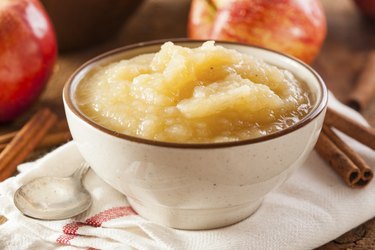
Slow-cooking apples to apple sauce or apple butter entails a relatively straightforward process. You need to only provide a low, steady heat to the apples and an occasional stir of the pot. Paradoxically, that very simplicity can sometimes get you into trouble. If you get distracted by other duties and neglect to stir your applesauce, it can stick to the bottom and scorch with surprising speed. The applesauce might or might not be salvageable, depending how badly it's burnt.
The Salvage Operation
Video of the Day
The moment your spoon or ladle finds scorched-on apples at the bottom of the pot, stop stirring and remove it from the heat. Taste your applesauce to see if it has an off-flavor. If not, quickly scoop away the top few inches of apple sauce to a new pot or container, and taste it again. Repeat until you begin tasting scorched apples, then discard the remainder. If you see flecks of burnt apple, screen them out by pushing the sauce through a fine-mesh strainer. A mildly scorched flavor isn't irreparable, and can usually be masked by sweetening or spicing the applesauce a little more heavily than usual.
Video of the Day
The Ounce of Prevention
The best way to rescue your applesauce is simply not to burn it in the first place. Use the heaviest-bottomed pot you own, because it will distribute heat more evenly and minimize "hot spots" that can cause scorching. Use a heat diffuser on a gas burner, or a wire ring on an electric element, to further reduce the risk. For worry-free, hands-off applesauce, prepare it instead in a slow cooker or a deep casserole dish in your oven. The diffused heat will break down your apples quite effectively over time, but without the risk of hot spots and burning.